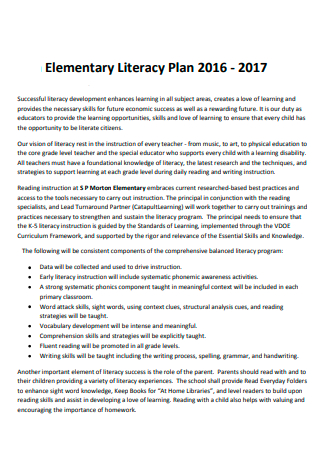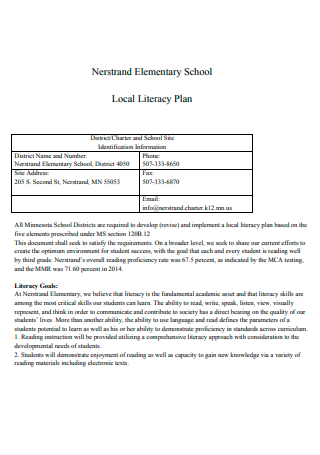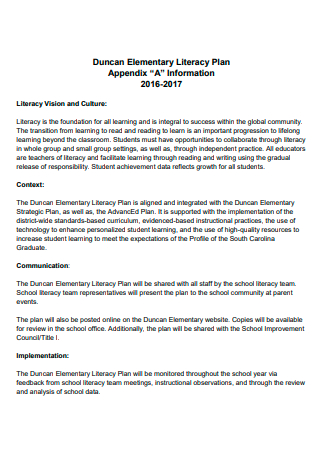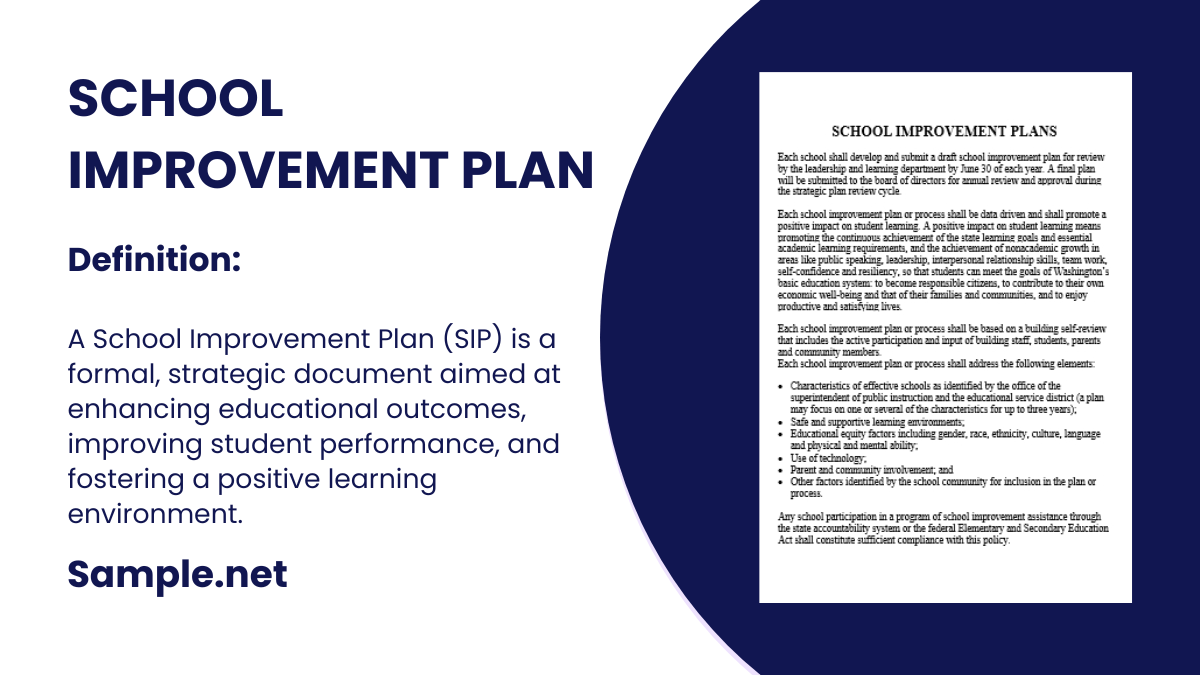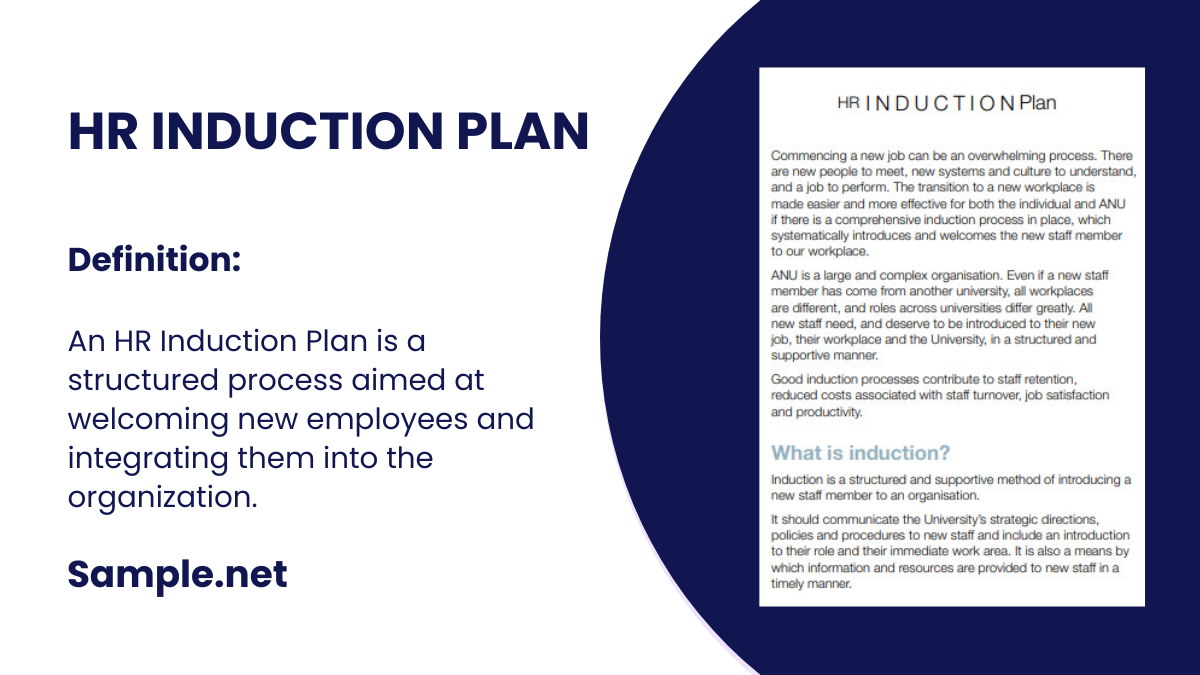A School Improvement Plan is a strategic blueprint aimed at enhancing educational outcomes for students. It outlines clear goals, targeted actions, and measurable benchmarks to ensure continuous development in…
continue readingSocial media, the ability to network with other people all around the world. To be able to read news, keep up with the current events, and understand what is happening all around us. More so with the students. Their application of literacy transforms them into socially evolved individuals. Their skills in reading and writing helps them participate in school activities and in life in general. If developed properly, their literacy skills help transform them into future leaders that helped shape future generations. Such is the all-encompassing impact of literacy. And it all begins with basic elementary literacy.
4+ SAMPLE Elementary Literacy Plan
What Is Elementary Literacy?
Let’s first define what literacy is. The National Literacy Trust in the UK has defined literacy as the ability to read, write, speak and listen in a way that lets us communicate effectively and make sense of the world. Let’s focus more on reading and writing. Reading is an essential part of the learning experience, expanding the knowledge of the reader. It can help to empower a child’s imagination, expand their knowledge and understanding of the world around them, and help them form the foundation of what kind of future lies ahead for them. Writing gives power to your thoughts. It turns that inner voice inside of you into something tangible and permanent. It helps shape your ideas and your ability to explain those ideas. As simple as the definition seems to sound, in reality, it’s far more complex than that. The ability to read and write is constantly changing and is dependent as well on the existing culture.
Different cultures have different understanding of what literacy is. Some cultures put significance on writing and on reading comprehension, especially on the English language, while for other cultures it has no importance at all. Global Citizen talks about how 9 out of 10 children in Africa don’t know how to read. Sounds unimaginable, doesn’t it? That’s the sad reality, however. The article goes on to talk about a study conducted by the ONE campaign shows that the global illiteracy crisis will be most evident in Africa if nothing is to be done to improve the global literacy situation, with 750 million children unable to read by the age of 10 by 2030, with sub-Saharan Africa alone accounting for 40% of children at risk. Because of this illiteracy crisis, children with underdeveloped literacy skills tend to be exposed to the dangers of being taken advantage of by other people due to their lack of comprehension. This situation tells us the urgency of the need for literacy to be taught during the early childhood years.
Components of Elementary Literacy
Having a successful and effective elementary literacy teaching program is no mean feat. There are different kinds of literacy programs out there to choose from, all of which use different components within their teaching program. Despite the differences in the literacy program, they should contain these basic components.
How to Create an Elementary Literacy Plan
Now that we have got into the nitty gritty of the components of elementary literacy, it’s time to make that elementary literacy plan. An Elementary Literacy Plan is an important blueprint or design to help map out an elementary student’s literacy success in reading and writing. It is similar to a literacy assessment. An effective elementary literacy plan can help develop students’ linguistic and cognitive skills through reading, writing, speaking, and listening across all areas and activities. Some of the objectives of an elementary literacy plan includes: aligning current instruction to the standards and putting emphasis on the commitment of teaching students; collaborate from end to end, school to school, home to school, et cetera; student engagement; regular assessment; Teaching reading that reflects practices that are based on quality research; planning towards mastery; ensuring students’ fluency at every level; offer intervention and remediation as necessary; and strategizing for complex content reading.
When making an literacy plan, be sure to incorporate all the components as previously mentioned. Make individual literacy plans based on each of those components. There are lots of literacy plan templates available out there that you can use to customize it according to your need, but we have more specific templates here on our website that you can use for your elementary literacy planning. There is no hard and fast rule to follow when making an elementary literacy plan. If you want to know more how to make one, below are the common guidelines or steps that is usually being used when creating an elementary literacy plan:
Lesson Planning
Lesson planning, or lesson plan, is the teacher’s workflow of what the students need to learn and how it is to be done during the class period. It incorporates what are the learning objectives, the learning activities to be taken, student assessment, the sequence of student engagement, timeline of student’s progress, and closing the lesson. Lesson planning can help teachers identify and plan around the areas of the different learning capability and needs of their students. It also serves as a teacher’s documentation throughout the process.
Building Background
Building background is an important part of literacy planning. Building background is about starting with where the students currently are, and getting them ready for what comes ahead in their lesson. This is making use of their existing basic knowledge, connecting it with the present, and slowly preparing them for the journey ahead.
Strategizing and Lesson Delivery
These are your action plans for each of the components of the literacy program. Create activities engaging the students. These activities should let the students make connections, visualize, infer, question, identify the importance, and theorize. For example, a reading activity. Make sure that they are able to understand what they have read by doing some practical applications. Another activity will be oral question and answer. Check their fluency and their choice of words. Create activities that invite them to socially interact with their peers. Maybe a little role playing here and there. Interaction is critical when making your strategies in the elementary literacy plan because it gauges the practical application of their existing word knowledge and skills. It helps them develop and improve their vocabulary and fluency. Your strategies and the way you deliver your lesson should be aligned with the goals you have set out in your lesson plan.
Review and Assessment
These are usually tests that are conducted to measure your students’ understanding of the lesson. When it comes to the elementary literacy plan, teachers measure students’ knowledge, interpret these assessments, and apply them to help students’ learning progress in literacy skills in reading and writing. This review and assessment can help the teacher identify which type of tools they’re going to use to further support each student’s needs in the literacy plan moving forward.
FAQs
What is a Literacy Plan?
A literacy plan is a program designed by the schools to help students, or learners, develop their linguistic and cognitive skills. It comes with objectives or a set of goals, a timeline, action plans to be taken, and assessments to be made for support or remediation.
Why is literacy important in elementary?
Having a good foundation of literacy skills in early childhood years is important to the child’s future communication performance. It also affects their ability to comprehend their environment. Literacy is important in elementary because it helps students meet their educational goals or milestones.
What are the benefits of having good literacy skills?
First, having good literacy skills promotes social interaction and networking. Since it is a communication skill, people with good literacy skills tend to build better relationships since they’re able to communicate and comprehend other people better by having a wide range of vocabulary and by being fluent. Next, having good literacy skills can help you climb the ladder in your professional career. Being able to communicate well, comprehend, and reason out is one of the attributes of a good professional. Last but not least, it promotes diversity. Having a wide range of vocabulary and comprehension means that you are able to understand different ranges of cultures. With comprehension comes understanding. With understanding comes acceptance. Basically, literacy bridges the gap between cultures through the art of communication.
As former US President Bill Clinton said, “Literacy is not a luxury, it is a right and a responsibility.” Having good literacy skills plays a very big important role for all of us, including children. Every child has the right to be educated, to learn how to read and write. Being educated is their protection and their security into the future. That’s why literacy should be taught in the early childhood years. To teach people how to communicate at an early age makes the world a better place to live in one step at a time.
If you would like to find out more about how to create that effective elementary literacy plan, check out our available resource templates on our website. We have templates available ready for download specifically made for elementary literacy planning. Help the world be a better place to live by teaching our kids how to read and write. Go ahead and download our template now, and get one step closer to creating that successful, effective literacy plan!
